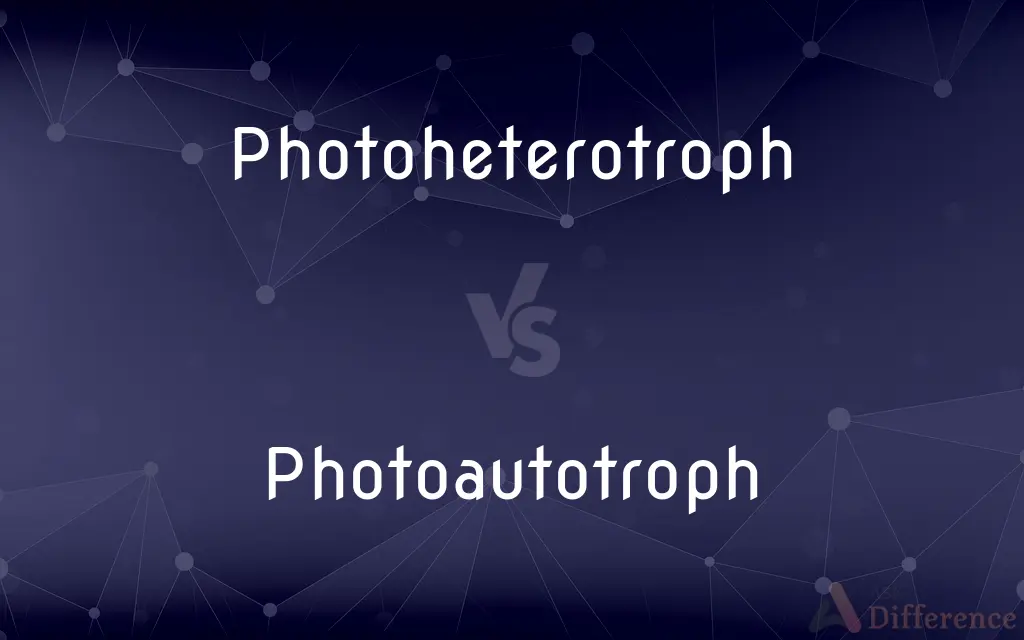Photoheterotroph vs. Photoautotroph — What's the Difference?
By Tayyaba Rehman & Maham Liaqat — Updated on April 16, 2024
Photoheterotrophs obtain energy from light but require organic compounds as carbon sources, while photoautotrophs use light for energy and CO2 as their sole carbon source.

Difference Between Photoheterotroph and Photoautotroph
Table of Contents
ADVERTISEMENT
Key Differences
Photoheterotrophs harness energy from light, similar to photoautotrophs, yet they differ fundamentally in their carbon sources. While photoheterotrophs depend on organic compounds for carbon, photoautotrophs utilize carbon dioxide, enabling them to be more self-sufficient in energy production. This difference influences their ecological roles and locations where they can thrive.
In terms of metabolic flexibility, photoheterotrophs can utilize both light and organic molecules, which allows them to adapt to varying environmental conditions where organic compounds are abundant. On the other hand, photoautotrophs, like plants and cyanobacteria, are often foundational to ecosystems as primary producers because they convert inorganic carbon from the atmosphere into organic matter.
Photoheterotrophs are not as widespread as photoautotrophs, largely due to their specific nutritional requirements. Whereas photoautotrophs are found in nearly all sunlit environments on Earth, dominating many terrestrial and aquatic ecosystems due to their ability to produce organic matter from CO2 and light.
The ecological impact of photoheterotrophs is generally more limited compared to photoautotrophs. While the former plays a role in consuming organic materials, thus contributing to the carbon cycle, photoautotrophs are crucial in carbon fixation and act as the primary producers in most food webs.
Both groups are essential in the study of microbial ecology and the evolution of photosynthesis. The understanding of photoheterotrophic mechanisms provides insights into microbial adaptability and niche differentiation, whereas the study of photoautotrophs is critical for understanding global carbon cycles and energy flow in ecosystems.
ADVERTISEMENT
Comparison Chart
Energy Source
Light
Light
Carbon Source
Organic compounds (e.g., carbohydrates)
Carbon dioxide (CO2)
Role in Ecosystem
Secondary consumers or decomposers
Primary producers
Distribution in Nature
Less widespread, more niche-specific
Widespread, found in all sunlit environments
Contribution to Carbon Cycle
Participate by consuming organic carbon
Crucial in carbon fixation, produce organic matter
Compare with Definitions
Photoheterotroph
Organisms that use light for energy but require organic substances for carbon.
Certain bacteria in sunlit zones of the ocean are photoheterotrophs.
Photoautotroph
Play a key role in global carbon cycles through photosynthesis.
Photoautotrophs remove CO2 from the atmosphere, reducing greenhouse gases.
Photoheterotroph
Less common than photoautotrophs, with a more specialized ecological niche.
Photoheterotrophs occupy specific roles that differ from those of photoautotrophs.
Photoautotroph
Organisms that use light for energy and CO2 as their sole carbon source.
Plants and algae are typical examples of photoautotrophs.
Photoheterotroph
They cannot fix carbon from CO2 and rely on external organic carbon sources.
Photoheterotrophic microbes often thrive where organic compounds are plentiful.
Photoautotroph
They are primary producers in ecosystems, creating organic matter from inorganic sources.
Photoautotrophs are crucial in forests, oceans, and freshwater environments.
Photoheterotroph
They contribute to the decomposition and nutrient cycling.
Photoheterotrophs help break down organic matter, releasing nutrients.
Photoautotroph
Dominant life forms in terms of biomass and ecological impact.
Photoautotrophs form the base of most terrestrial and aquatic food webs.
Photoheterotroph
Found primarily in aquatic environments, including oceans and freshwater.
Many photoheterotrophs are integral to nutrient cycles in aquatic ecosystems.
Photoautotroph
Can thrive in a variety of environments, including extreme conditions.
Some algae species are photoautotrophs even under ice in polar regions.
Photoheterotroph
Photoheterotrophs (Gk: photo = light, hetero = (an)other, troph = nourishment) are heterotrophic phototrophs – that is, they are organisms that use light for energy, but cannot use carbon dioxide as their sole carbon source. Consequently, they use organic compounds from the environment to satisfy their carbon requirements; these compounds include carbohydrates, fatty acids, and alcohols.
Photoautotroph
See phototroph.
Photoheterotroph
A heterotrophic organism that uses light for energy but cannot use carbon dioxide as its sole carbon source and thus uses organic compounds from the environment.
Photoautotroph
(biology) an organism, such as all green plants, that can synthesize its own food from inorganic material using light as a source of energy
Common Curiosities
Where are photoautotrophs mainly found?
They are found in nearly all environments that have light, from terrestrial to aquatic systems.
How do photoheterotrophs differ from photoautotrophs in their role in ecosystems?
Photoheterotrophs act as consumers or decomposers, whereas photoautotrophs serve as primary producers.
Can photoheterotrophs fix carbon from CO2?
No, they rely on organic carbon sources and cannot fix carbon from CO2.
What are photoheterotrophs?
Photoheterotrophs are organisms that use light for energy but must obtain carbon from organic sources.
What are photoautotrophs?
Photoautotrophs are organisms that use light for energy and carbon dioxide as their carbon source.
Why are photoautotrophs important to the environment?
They are crucial for carbon fixation and serve as the foundational producers in food webs.
What is a common example of a photoheterotroph?
Certain types of bacteria in aquatic environments are photoheterotrophs.
What adaptations help photoautotrophs survive in diverse environments?
Their ability to use sunlight and CO2 allows them to inhabit diverse and often extreme environments.
How do photoheterotrophs contribute to nutrient recycling?
They help decompose organic materials, thus recycling nutrients within ecosystems.
How do the nutritional needs of photoheterotrophs affect their distribution?
Their need for organic carbon limits them to environments where these resources are available.
What is a common example of a photoautotroph?
Plants and cyanobacteria are common examples of photoautotrophs.
How do photoautotrophs impact global climate?
They reduce atmospheric CO2, impacting global climate conditions by mitigating greenhouse effects.
Are all photoheterotrophs bacteria?
While many are bacteria, some other microbes also exhibit photoheterotrophic behaviors.
Do photoautotrophs require organic nutrients?
No, they produce their own nutrients through photosynthesis using inorganic materials.
Are photoheterotrophs less efficient than photoautotrophs?
In terms of energy and carbon independence, yes, as they depend on external organic carbon sources.
Share Your Discovery

Previous Comparison
Reiterate vs. Iterate
Next Comparison
Steep vs. SeepAuthor Spotlight
Written by
Tayyaba RehmanTayyaba Rehman is a distinguished writer, currently serving as a primary contributor to askdifference.com. As a researcher in semantics and etymology, Tayyaba's passion for the complexity of languages and their distinctions has found a perfect home on the platform. Tayyaba delves into the intricacies of language, distinguishing between commonly confused words and phrases, thereby providing clarity for readers worldwide.
Co-written by
Maham Liaqat













































